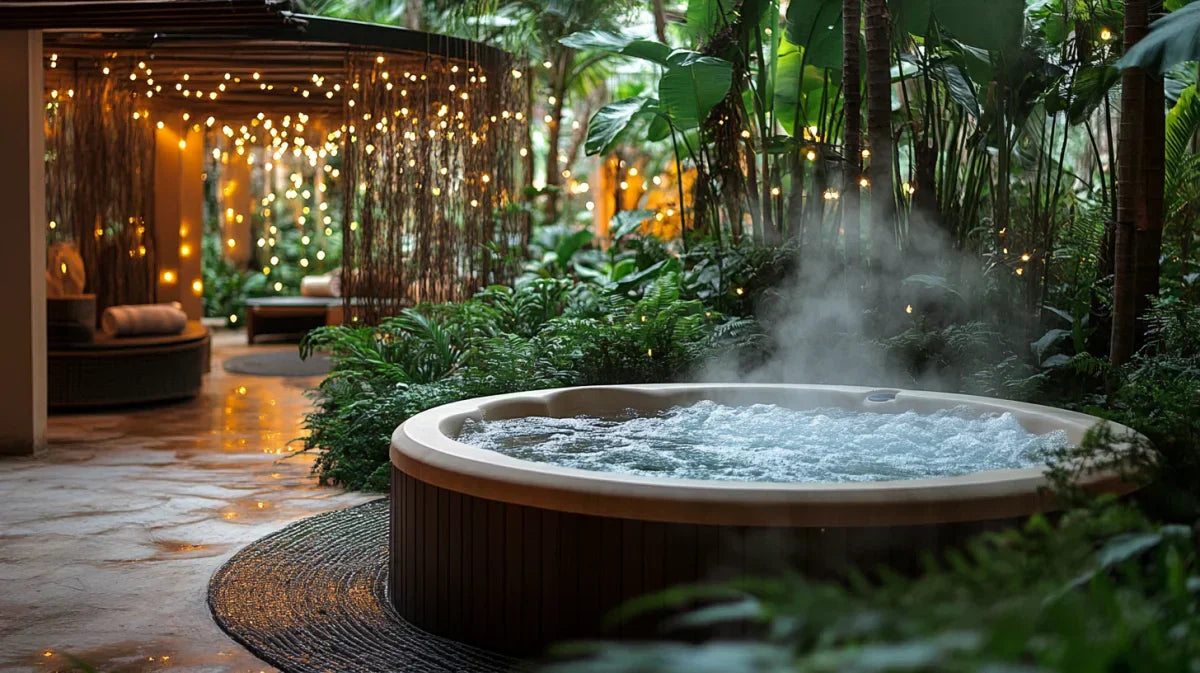Inflatable hot tubs, also known as portable spas or plug-and-play hot tubs, have soared in popularity in recent years. With an affordable price point and easy setup, it's no wonder more households are welcoming these relaxing at-home oases.
But before taking the plunge into hot tub ownership, it's important to understand the true costs involved in keeping your inflatable hot tub warm, clean, and operating all year round. In this guide, we'll break down the real-world factors that impact your energy, water, chemical, and maintenance costs. Read on to learn how to maximize efficiency and savings based on your climate, usage, and more. For a deeper dive into the importance of hot tub insulation, check out our comprehensive guide on keeping your spa energy-efficient.
Average Inflatable Hot Tub Electricity Usage
The biggest ongoing expense for an inflatable hot tub is electricity for heating and operating the pump and filtration system. Most models use between 3.5 and 6 kWh (kilowatt hours) per day on average. However, energy use can vary quite a bit based on these factors: To understand more about energy costs, explore tips and strategies for efficiency and discover how proper insulation can lead to significant savings.
-
Outside temperature - Colder weather causes the most significant increases in electricity usage. Heating the water takes more energy when it's frigid outside. In peak winter, an inflatable hot tub may use 6+ kWh daily compared to only 3-4 kWh on warmer spring and fall days.
-
Frequency of use - The more often you get in your hot tub, the more it will need to reheat and filter the water after each session. Frequent daily use will consume more kWh than occasional weekend-only use.
-
Duration of use - Similarly, longer hot tub sessions require more reheating and filtration afterward, using more electricity. A quick 30-minute dip will use less power than a 2-3 hour family soak.
-
Jet usage - Running the hot tub's massage jets uses a lot of pumping power. Minimizing total jet time can help save electricity.
-
Temperature setting - Maintaining a higher constant water temperature (like 40°C vs. 35°C) requires more continual heating and electricity.
-
Insulation - A well-insulated cover and side jackets greatly reduce heat loss and electricity usage. This can cut costs by 50% or more. We'll discuss insulation savings more below.
-
Hot tub size - Larger model tubs with more water capacity require more power for heating and operation. An 8-person may use 1-2 more kWh per day than a 2-person.
-
Electricity rates - Time-of-use rates that charge more per kWh during peak daytime hours will impact costs more compared to flat rates.
Electricity Costs in the UK
Understanding the monthly and yearly electrical costs of running your inflatable hot tub in the UK requires insight into the nation's electricity rates. While these rates can vary based on various factors, recent regulations such as the "Energy Price Guarantee" have been introduced to provide stability and predictability for consumers.
Although specific rates can differ across regions, households in the UK generally encounter electricity prices influenced by global energy markets, local policies, and other economic factors. It's essential to be aware of these elements and monitor any updates, especially if you're aiming to run an energy-intensive appliance like an inflatable hot tub efficiently.
For a comprehensive understanding of how the Energy Price Guarantee and other factors might influence your hot tub's running costs, it's advisable to consult local energy suppliers or refer to UK energy market reports.
As a base example, if your inflatable hot tub uses 4 kWh per day on average, at a rate of 30p/kWh your monthly electric cost for the hot tub would be around ~£ 36 for daily use.
To get the most accurate estimate, look up your local residential electricity rate from your utility company, then multiply it by your hot tub's average expected daily kWh usage.
Impact of Weather on Hot Tub Heating Costs
As we touched on earlier, ambient air temperature significantly impacts electricity costs in large part due to hot tub heating. Colder months with lower temperatures require more energy to maintain your hot tub water at the desired warmth.
As you can see, keeping the water heated during January and December requires around twice as many kWh compared to June through August.
This wintertime increase in heating-related energy use directly affects monthly costs. If your hot tub electricity rate is 30p/kWh, the usage increase from 4 kWh on a summer day to 8 kWh on a winter day would raise your daily electricity cost from £4.80 to £9.60 - pretty much doubling it.
Savings from Hot Tub Insulation
One of the most effective ways to reduce your inflatable hot tub's heating costs and energy usage is insulation. High-quality hot tub insulation traps heat and slows heat loss, reducing the amount of energy needed for reheating.
Here are the main types of insulation products for inflatable hot tubs:
-
Hot tub covers - A thick insulated lid helps retain heat and moisture when the hot tub isn't being used. They'll typically reduce heat loss by 30-50%.
-
Side insulation jackets - Insulated Jackets wrap around the exterior sides to prevent heat escaping through the inflatable walls. Savings of 30-60% are common.
-
Bottom insulation mats - Placing your hot tub on an insulated foam mat instead of directly on the ground prevents cold transfer and reduces heat loss through the bottom by up to 50%.
Together, a full set of cover, side, and bottom insulation can cut electricity usage by 50-70% or more compared to an uninsulated inflatable hot tub. This translates to massive savings, especially in cold weather.
Insulation also helps your hot tub heat up much faster after adding cold water - reducing electricity needed for reheating. And insulation extends the life of the heater and pump by reducing their required runtime.
Here's a chart showing typical electricity usage ranges with and without insulation:
| Daily kWh Usage | Daily Cost (£) | Reduced Daily Cost (£) | Monthly Cost (£) | Reduced Monthly Cost (£) | Monthly Savings (£) |
|---|---|---|---|---|---|
| 3 | 3.60 | 1.08 | 108.00 | 32.40 | 75.60 |
| 4 | 4.80 | 1.44 | 144.00 | 43.20 | 100.80 |
| 5 | 6.00 | 1.80 | 180.00 | 54.00 | 126.00 |
| 6 | 7.20 | 2.16 | 216.00 | 64.80 | 151.20 |
| 7 | 8.40 | 2.52 | 252.00 | 75.60 | 176.40 |
As you can see, insulation makes a dramatic impact on energy consumption. An uninsulated hot tub may use 5-6+ kWh daily in winter compared to only 2-3 kWh when well-insulated - cutting usage in half.
Pump Efficiency Differences
Not all inflatable hot tub pump and heating systems are equal when it comes to energy efficiency. There can be significant variation between models and brands when it comes to kWh required for heating, filtration, and jet operation.
For example, more efficient massage jet pumps use less wattage while still offering therapeutic spa jet benefits. Some hot tub filter systems clean the water more thoroughly while consuming less electricity. And modern, tech-enabled heating systems can sustain safe water temperatures using less energy than outdated heating units. Effective hot tub pump insulation can increase thermal efficiency and provide some accoustic insulation.
If evaluating multiple inflatable hot tub models, pay attention to product specifications and reviews related to energy efficiency. Some manufacturers are focusing more on these improvements than others. An efficient system can save you money monthly on your utility bill.
Hot Tub Size and Usage Patterns
Hot tub size and frequency of use also impact energy costs. As mentioned earlier, larger 6-8 person inflatable models require more power for heating and operating compared to smaller 2-4 person versions. The more water volume, the more energy used.
And the more often you use your hot tub each week, and the longer your average soak sessions, the more it will need to reheat and filter afterward. Conserving energy is easier if you mainly use your spa occasionally for short dips rather than daily for hours.
Here are a few tips to maximize efficiency based on your usage patterns:
- Set a timer for your soaks to avoid excessively long sessions.
- Limit use of jets to 10-15 minutes at a time.
- In summer, only heat to body temperature (35-37°C).
- Rinse with cold water before refilling to avoid reheat energy use.
- In winter, drain fully after each use to avoid losing heat.
- Limit use on extremely cold days.
Estimated Annual Savings
To demonstrate the potential pound savings from hot tub insulation over 12 months, let's look at some hypothetical examples:
Un-insulated 4-person Hot Tub
- Heating Usage:
- Summer: 4 kWh/day
- Winter: 8 kWh/day
- Average Rate: 30p/kWh
- Average Use: 4hrs/daily, Twice a week
- Annual Cost = £500
Fully Insulated 4-person Hot Tub
- Heating Usage:
- Summer: 2 kWh/day
- Winter: 3 kWh/day
- Average Rate: 30p/kWh
- Average Use: 4hrs/daily, Twice a week
- Annual Cost = £149
Estimated Annual Savings = £ 239.44
The insulation reduces usage by 50% and cuts the annual electricity cost by around 60% in this example.
Savings will be even more substantial in colder climates where winters are longer. With extreme low temperatures, an un-insulated inflatable hot tub may use 10+ kWh per day for months on end. Quality inflatable hot tub insulation becomes even more valuable. As you can see, the annual savings quickly add up, making insulation a worthwhile investment.
Payback Periods
When looking at insulation, an important consideration is the payback period - how long it takes the energy savings to surpass the upfront insulation cost.
Here are typical costs along with average payback periods for hot tub insulation:
| Insulation Type | Cost | Estimated Payback |
|---|---|---|
| Hot Tub Cover | £ 150 - 200 | 1 winter season |
| Side Insulation Jacket | £ 160 - 230 | 1-2 winter seasons |
| Bottom Insulation Mat | £ 75.00-£ 129.50 | 3-6 months |
With a full set of insulation installed, most owners recover their costs within a year by saving on heating expenses. And the savings continue year after year after that.
Conclusion
The real costs of running an inflatable hot tub involve electricity, maintenance, water, chemicals, cleaning time, and more. But paying attention to energy efficiency by maximizing insulation and smart usage can yield significant long-term savings.
With a well-insulated cover, side jacket, and mat, you can cut electricity costs in half compared to running an uninsulated hot tub. And the insulation often pays for itself within a single winter season of usage through your energy savings.
While operating an inflatable hot tub does have ongoing costs, a small investment in insulation helps keep expenses lower while maximizing the relaxation and health benefits these wonderful home spas provide all year round.



